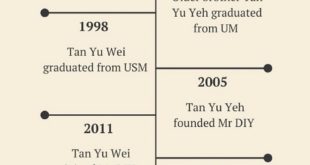Bottom Line: I’ve never been a studious person. I hated homework and revision, and if you flipped through my workbooks, you’d find completely empty pages in between daily homework that I left “to complete one day”. But if I could have levelled up my academic knowledge through an app back then, would I really have been more excited for revision?
That’s what the co-founders of Pandai are hoping for.
Pandai is an educational app whereby students can do daily quizzes, tests and exams that suit their curriculum to increase their knowledge of a subject.
Co-founder Khairul told Vulcan Post that the team is aware that students spend a lot of time on mobile devices already, albeit with little to no academic content in their daily usage patterns.
He also shared that according to the Malaysian Communications and Multimedia Commission (MCMC), 85% of Malaysian students aged 5 to 17 already have access to mobile phones, and 75% of them have access to the internet.
Therefore, this is where Pandai aims to capitalise on the trend.
Tackling Tough Tasks First
The game plan for the team is for their app to cover all academic subjects at both primary and secondary level, but they began by emphasising science and mathematics subjects like Additional Mathematics, Physics, Biology, and more.
“These subjects have the reputation of being the most difficult subjects and there is a high demand for preparation materials for them,” Khairul reasoned.
Users can access Pandai’s features in 2 different modes: Daily Quizzes, and Tests & Exams.
Daily Quizzes work as a daily challenge that comes in a set of 3-5 problems for each subject, and it’s given in every subject following the schedule of how they’re taught in school.

They’re designed to map to the chapters, topics and subtopics in the national curriculum, which are explained in the Dokumen Standard Kurikulum & Pentaksiran (DSKP), a document issued by the Ministry of Education.
In Tests & Exams, students can get full-length tests based on the topics in each chapter.
They can also get midterm and final exams at the corresponding periods in the academic calendar, namely in May and September.
Being so differently structured, these two modes of course have their own objectives.
Daily Quizzes are aimed for consistent engagement, taking only a short duration for completion and are to be done on a daily basis, while Tests & Exams are aimed towards giving students deeper comprehension in a more structured way.
“While it may seem that Pandai only has assessment content, the real secret sauce is in the explanations to all the quizzes and tests,” Khairul added.
The Pandai content team took great care in detailing and explaining every step and fact used in the solution as they believe students would be more interested to know why they were right or wrong.
“The explanations that appear in Pandai do not simply explain why the answer is such-and-such, but go even further to explain the thought process behind an answer,” Khairul said.
He elaborated, “Sometimes we even provide historical/real-life context to the material that appears in the curriculum (for example, the history of Fibonacci sequence that appear in Mathematics).”
Making Learning ‘Fun’
Pandai has both a free version and a Pandai Premium subscription option for those who want more content.
The latter includes a higher number of daily quizzes, additional tests and exams, preparation contents for various educational competitions, and other premium features which they add regularly.
But with all this talk about helping students get better at their academia, we asked Khairul how they actually measure the success of their app’s purpose.
According to his reply, it really boils down to the student’s discipline.
“The purpose of Pandai is as a self-diagnostic tool, similar to how students use exercise books. It is not meant to replace classroom teaching and human engagement in school,” he said.
“Therefore, as any self-diagnostic tool, the key to successful use is regularity. Students who use Pandai regularly should see an improvement in their comprehension of the subject.”
And to keep students interested in learning through Pandai, the team has introduced a few gamification elements that allow students to build their Pandai assets.
“At the moment, we discover that students who use Pandai daily do so in order to complete new challenges every day to maintain their daily streaks which are recorded on their dashboard,” Khairul shared.

For certain streaks and achievements, students can unlock badges.
To me, this concept sounded familiar—I’ve used Duolingo, the international language learning app before, and it did what Pandai is now doing.
And speaking of language, Pandai’s content currently comes in two languages, Bahasa Melayu and English.
Keeping Parents And Teachers In The Loop
In just 3 months, Pandai has managed to sign up 5,000 active students to their app.
But they haven’t forgotten about the parents and teachers either.
Currently, they are developing upcoming features for parents like monitoring tools and data analytics for their children’s performance as well as printable tests.
For teachers, they’re creating a crowdsourced question bank where teachers can be incentivised to submit their own content, a quiz/homework generator, and monitoring tools for students in their class.
While the journey has been nothing but fun for the Pandai team, their main challenge has been to identify the actual demands among users.
“The general public have opinions about education and are happy to give them unsolicited, but people seldom go out of their way to observe actual students’ behaviour and collect field data,” Khairul noted.
So, the way the team approaches demand is through observing how students engage with the app, and asking them about the pain points and what improvements they’d want to see in the app.

“It is tempting to think that an education app should have this and that features, and incorporate this and that pedagogical tools, while in reality what the actual customers want and are willing to pay for are totally different,” Khairul said.
He also shared that Pandai has embarked on a 3-year execution phase to develop other features and explore other educational markets in the region.
Simultaneously, they’re in the process of developing an adaptive learning system using AI and machine learning to personalise Pandai content to each user.
“With Artificial Intelligence Assisted Learning (AIAL), students will be able to grow at their own pace, while the system learns about students’ strengths and weaknesses and adapt the content correspondingly,” he added.
For the long-term, Pandai wants to create a content-rich online platform that’s accessible from the web and mobile devices.
It shall be able to simulate the learning and assessment experience of a physical classroom, without replacing the need for social interaction that takes place in one.
Bottom Line: I think I would definitely be more inclined to spend my time revising on an app that looks nice instead of trying to focus on a boring B&W paper. However, knowing me, the danger of me getting distracted by other apps and not learning would always be lurking around a corner.
- You can read more about other Malaysian startups here.
Featured Image Credit: Pandai



